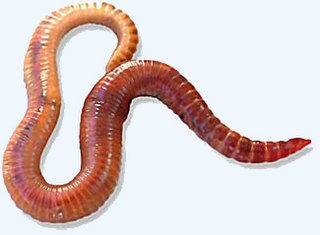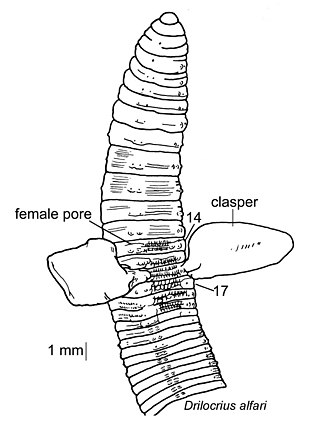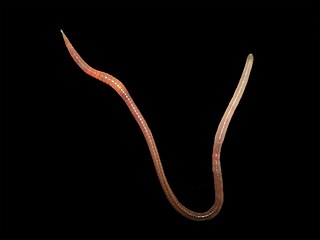
The Lumbricidae are a family of earthworms. About 33 lumbricid species have become naturalized around the world, but the bulk of the species are in the Holarctic region: from Canada and the United States and throughout Eurasia to Japan. An enigmatic species in Tasmania is Eophila eti. Currently, 670 valid species and subspecies in about 42 genera are recognized. This family includes the majority of earthworm species well known to Europeans and Asians

Oligochaeta is a subclass of animals in the phylum Annelida, which is made up of many types of aquatic and terrestrial worms, including all of the various earthworms. Specifically, oligochaetes comprise the terrestrial megadrile earthworms, and freshwater or semiterrestrial microdrile forms, including the tubificids, pot worms and ice worms (Enchytraeidae), blackworms (Lumbriculidae) and several interstitial marine worms.

Megascolecidae is a taxonomic family of earthworms native to Madagascar, Australia, New Zealand, Southeast Asia, and North America. All species of the Megascolecidae belong to the Clitellata class. The Megascolecidae comprise a large family of earthworms and they can grow up to 2 meters in length. The intercontinental distribution of Megascolecidae species favours the continental drift theory.
Sparganophilus, the only genus in the family Sparganophilidae, is a group of long, slender, limicolous (mud-dwelling) earthworms native to North America. The number of species is unknown, most of them are undescribed, throughout the continent and into Central America. One species, S. tamesis, has been introduced into the streams of Europe, where it is now widespread; its synonyms are S. eiseni, S. benhami, S. guatemalensis, S. carnea, S. elongatus, S. cuenoti and, newly, S. langi.

Eisenia fetida, known under various common names such as manure worm, redworm, brandling worm, panfish worm, trout worm, tiger worm, red wiggler worm, etc., is a species of earthworm adapted to decaying organic material. These worms thrive in rotting vegetation, compost, and manure. They are epigean, rarely found in soil. In this trait, they resemble Lumbricus rubellus.

The Clitellata are a class of annelid worms, characterized by having a clitellum - the 'collar' that forms a reproductive cocoon during part of their life cycles. The clitellates comprise around 8,000 species. Unlike the class of Polychaeta, they do not have parapodia and their heads are less developed.

The Kinabalu giant earthworm, Pheretima darnleiensis, is a grey-blue coloured peregrine annelid. It is found widely in Southeast Asia, primarily in the Indo-Australasian Archipelago, but also in Peninsular Malaysia. Records from the Caroline Islands and Fiji are believed to represent introductions. This also applies to the eponymic Darnley Island record.

The animal family Almidae includes about six genera of segmented worms.
The Acanthodrilidae are an ancient and widely distributed family of earthworms which has native representatives in Australia, New Zealand, South Africa, South America, and North America. No native species are known from India nor Asia. The family possibly shows a pre-Pangaean distribution.

An earthworm is a soil-dwelling terrestrial invertebrate that belongs to the phylum Annelida. The term is the common name for the largest members of the class Oligochaeta. In classical systems, they were in the order of Opisthopora since the male pores opened posterior to the female pores, although the internal male segments are anterior to the female. Theoretical cladistic studies have placed them in the suborder Lumbricina of the order Haplotaxida, but this may change. Other slang names for earthworms include "dew-worm", "rainworm", "nightcrawler", and "angleworm". Larger terrestrial earthworms are also called megadriles as opposed to the microdriles in the semiaquatic families Tubificidae, Lumbricidae and Enchytraeidae. The megadriles are characterized by a distinct clitellum and a vascular system with true capillaries.
Rhinodrilus fafner is a presumed extinct giant earthworm from the family Glossoscolecidae. It is only known by the ill-preserved holotype discovered in 1912 near Belo Horizonte in the Brazilian state of Minas Gerais and described in 1918 by German zoologist Wilhelm Michaelsen (1860–1937) from the National History Museum in Hamburg. The collected individual has a length of 210 centimetre and the body which consists of 600 single segments is 24 millimetre in diameter. Along with Amynthas mekongianus and Megascolides australis, Rhinodrilus fafner is among the largest known giant earthworms. Rhinodrilus fafner was confined to a small habitat and vanished possibly due to habitat destruction. It was officially declared extinct by the Brazilian Ministry of Environment (MMA) in 2003. However, the rediscoveries of the Giant Palouse earthworm in 2005 and the Brazilian earthworm Fimoscolex sporadochaetus in 2007 created hope that Rhinodrilus fafner may be found again.
Microchaetus rappi, the African giant earthworm, is a large earthworm in the Microchaetidae family, the largest of the segmented worms. It averages about 1.4 meters in length, but can reach a length of as much as 6.7 meters and can weigh over 1.5 kilograms.
Earthworms are invasive species throughout the world. Of a total of about 6,000 species of earthworm, about 120 species are widely distributed around the globe. These are the peregrine or cosmopolitan earthworms. Some of these are invasive species in many regions.
Diplocardia longa is a species of earthworm native to North America. It was first described by the American zoologist John Percy Moore in 1904. The type locality is Hawkinsville, Georgia. This worm has bioluminescent properties; its body fluids and the sticky slime it exudes when stimulated emit a bluish glow.
Octochaetus multiporus, commonly known as the New Zealand earthworm, is a megascolecid worm endemic to New Zealand. It is mainly found in the south of Manawatu but may also be found along the east coast of the South Island. A bioluminescent worm, Octochaetus multiporus secretes a luminescent fluid from its mouth when disturbed or punctured.
Moniligastridae is a family of earthworms native to South and Eastern Asia, containing around 200 species and five genera.

Amynthas mekongianus, the Mekong worm or Mekong giant earthworm, previously known as Megascolex mekongianus, is a species of earthworm in the family Megascolecidae. It is native to the vicinity of the River Mekong in southeastern Asia and may have more than 500 segments and grow to a length of 2.9 m (10 ft).

Pontoscolex is a genus of earthworms in the family Glossoscolecidae, or alternatively, in the family Rhinodrilidae.
Megascolecidae earthworm Amynthas japonicus was a Japanese native probably collected from Nagasaki in the 1820s. It was one of three native earthworms featured in Dr P.F.B. von Siebold’s extensive collection and recorded as one of Japan’s earliest pheretimoid species. It is now deemed extinct given that a 2018 Nagasaki expedition and earlier 1930s reports failed to locate it. It is featured on The Recently Extinct Plants and Animals Database.
Opisthopora is an order of mostly terrestrial worms.








